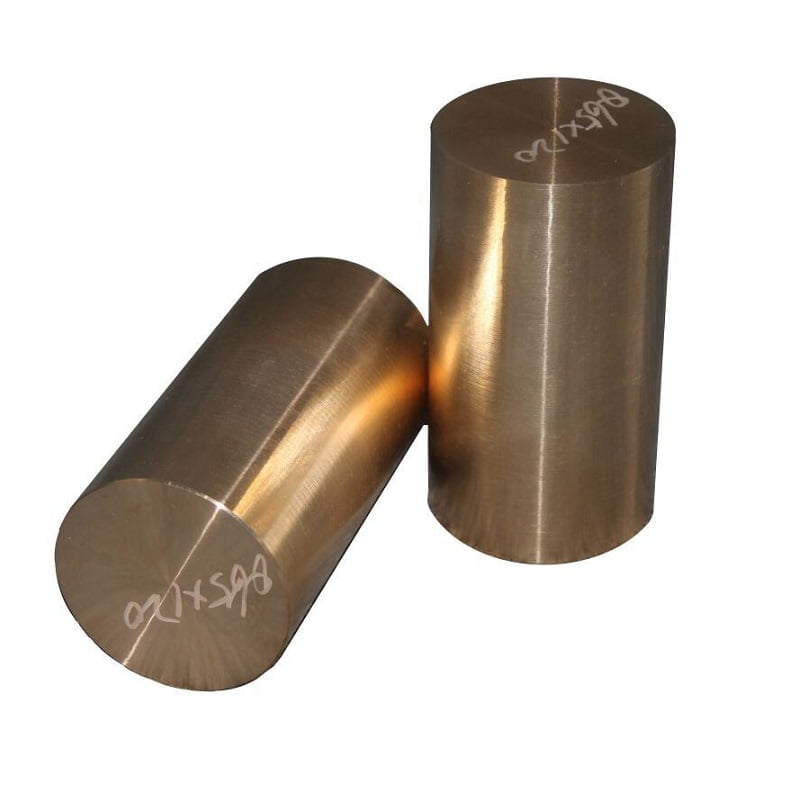
Einführung
C17510 und C17200 sind beide Berylliumkupferlegierungen, bekannt für ihre hervorragende Kombination aus hoher Festigkeit, Leitfähigkeit und Korrosionsbeständigkeit. Diese Legierungen werden häufig in verschiedenen Branchen eingesetzt, darunter Luft- und Raumfahrt, Automobil, Elektronik sowie Öl und Gas. Obwohl sie einige Gemeinsamkeiten aufweisen, verfügen sie auch über unterschiedliche Eigenschaften, die sie für unterschiedliche Anwendungen geeignet machen.
Chemische Zusammensetzung
Die chemische Zusammensetzung dieser Legierungen spielt eine entscheidende Rolle bei der Bestimmung ihrer Eigenschaften und Leistung.
| nach Extrusionsabschrecken und künstlicher Alterung HBS≥80 | C17510 (Gew.-%) | C17200 (Gew.-%) |
|---|---|---|
| Kupfer | 98,1 – 99,5 | 96,5 – 98,1 |
| Beryllium | 0.2 – 0,6 | 1,8 – 2,0 |
| Kobalt + Nickel | 0.2 – 1.4 | 0.2 – 0,6 |
| nach Extrusionsabschrecken und künstlicher Alterung HBS≥80 | 0.1 – 0,4 | Maximal 0,2 |
| Aluminium | – | Maximal 0,2 |
| nach Extrusionsabschrecken und künstlicher Alterung HBS≥80 | – | Maximal 0,2 |
| Andere | Maximal 0,5 | Maximal 0,5 |
Der Hauptunterschied in der Zusammensetzung ist der Berylliumgehalt, der bei C17200 deutlich höher ist. Dieser Unterschied beeinflusst verschiedene Eigenschaften der Legierungen.
Mechanische Eigenschaften
Die mechanischen Eigenschaften sind entscheidend für die Eignung dieser Legierungen für bestimmte Anwendungen.
| Eigentum | C17510 | C17200 |
|---|---|---|
| Zugfestigkeit (MPa) | 655 – 795 | 1140 – 1310 |
| Streckgrenze (MPa) | 520 – 725 | 965 – 1140 |
| Dehnung (%) | 10 – 20 | 3 – 10 |
| Härte (HRB) | 90 – 100 | 97 – 105 |
| Elastizitätsmodul (GPa) | 131 | 131 |
C17200 weist im Allgemeinen eine höhere Festigkeit und Härte auf, während C17510 eine bessere Duktilität (Dehnung) bietet.
Physikalische Eigenschaften
Physikalische Eigenschaften sind wichtig für Anwendungen mit thermischer und elektrischer Leitfähigkeit.
| Eigentum | C17510 | C17200 |
|---|---|---|
| Dichte (g/cm³) | 8,83 | 8.25 |
| Elektrische Leitfähigkeit (%IACS) | 45 – 65 | 22 – 28 |
| Wärmeleitfähigkeit (W/m·K) | 208 – 300 | 105 – 130 |
| Wärmeausdehnungskoeffizient (µm/m·°C) | 17.8 | 17.0 |
| Schmelzbereich (°C) | 870 – 980 | 870 – 980 |
C17510 weist im Vergleich zu C17200 eine überlegene elektrische und thermische Leitfähigkeit auf.
Wärmebehandlung
Beide Legierungen können durch Wärmebehandlung verstärkt werden, die Verfahren und Ergebnisse unterscheiden sich jedoch:
| Aspekt | C17510 | C17200 |
|---|---|---|
| Lösungsbehandlung | 900 – 925°C | 760 – 780°C |
| Alterungstemperatur | 460 – 480°C | 315 – 345°C |
| Alterungszeit | 2 – 3 Stunden | 2 – 3 Stunden |
| Kraftsteigerung | Mäßig | Bedeutsam |
Aufgrund seines höheren Berylliumgehalts erreicht C17200 typischerweise eine deutlichere Festigkeitssteigerung durch Wärmebehandlung.
Korrosionsbeständigkeit
Beide Legierungen weisen eine hervorragende Korrosionsbeständigkeit auf, es gibt jedoch einige Unterschiede:
| Umfeld | C17510 | C17200 |
|---|---|---|
| Atmosphärisch | Exzellent | Exzellent |
| Meerwasser | Sehr gut | Sehr gut |
| Säuren | Gut | Gut |
| Alkalien | Gut | Gut |
| Spannungsrisskorrosionsbeständigkeit | Exzellent | Sehr gut |
C17510 kann aufgrund seines geringeren Berylliumgehalts eine leichte Verbesserung der Spannungsrisskorrosionsbeständigkeit aufweisen.
Herstellungseigenschaften
Die Verarbeitungseigenschaften dieser Legierungen sind für Herstellungsprozesse wichtig:
| Charakteristisch | C17510 | C17200 |
|---|---|---|
| Bearbeitbarkeit | Gut | Gut |
| Formbarkeit | Sehr gut | Gut |
| Schweißbarkeit | Gut | Gerecht |
| Heißes Arbeiten | Gut | Gut |
| Kaltumformung | Exzellent | Sehr gut |
C17510 bietet aufgrund seines geringeren Berylliumgehalts und seiner höheren Duktilität im Allgemeinen eine bessere Formbarkeit und Schweißbarkeit.
Anwendungen
Die einzigartigen Eigenschaften jeder Legierung machen sie für verschiedene Anwendungen geeignet:
C17510 Anwendungen:
- Elektrische Anschlüsse
- Hochleistungsfedern
- Widerstandsschweißelektroden
- Kühlkörper
- Leiterrahmen für integrierte Schaltkreise
- Lager und Buchsen
- Funkenfreie Werkzeuge
C17200 Anwendungen:
- Hochfeste Federn
- Membranen
- Balg
- Präzisionsinstrumente
- Formen für den Kunststoffspritzguss
- Lager in korrosiven Umgebungen
- Chirurgische und zahnmedizinische Instrumente
Kostenüberlegungen
Die Kosten dieser Legierungen können je nach Marktbedingungen und Verfügbarkeit variieren:
| Faktor | C17510 | C17200 |
|---|---|---|
| Rohstoffkosten | Untere | Höher |
| Bearbeitungskosten | Mäßig | Mäßig bis hoch |
| Gesamtkosten | Untere | Höher |
C17200 ist aufgrund seines höheren Berylliumgehalts im Allgemeinen teurer.
Umwelt- und Sicherheitsaspekte
Beide Legierungen enthalten Beryllium, was eine sorgfältige Handhabung erfordert:
| Aspekt | C17510 | C17200 |
|---|---|---|
| Berylliumgehalt | Niedriger (0,2 – 0,6 %) | Höher (1,8 – 2,0 %) |
| Staubgefahr | Mäßig | Höher |
| PSA-Anforderungen | Standard | Erweitert |
| Recycling | Einfacher | Komplexer |
Der geringere Berylliumgehalt in C17510 erleichtert die Handhabung und das Recycling etwas.
Vergleichszusammenfassung
| Charakteristisch | C17510 | C17200 |
|---|---|---|
| Stärke | Gut | Exzellent |
| Leitfähigkeit | Exzellent | Gut |
| Duktilität | Sehr gut | Gut |
| Korrosionsbeständigkeit | Exzellent | Exzellent |
| Herstellbarkeit | Sehr gut | Gut |
| Kosten | Untere | Höher |
| Sicherheitsüberlegungen | Mäßig | Höher |
Fazit
Sowohl C17510 als auch C17200 sind Hochleistungs-Kupfer-Beryllium-Legierungen mit hervorragenden Kombinationen aus Festigkeit, Leitfähigkeit und Korrosionsbeständigkeit. Die Wahl zwischen ihnen hängt von den spezifischen Anforderungen der Anwendung ab:
- Wählen Sie C17510, wenn:
- Eine höhere elektrische und thermische Leitfähigkeit ist erforderlich
- Eine bessere Formbarkeit und Schweißbarkeit sind erforderlich
- Die Kosten sind ein wesentlicher Faktor
- Aus Sicherheitsgründen wird ein geringerer Berylliumgehalt bevorzugt
- Wählen Sie C17200, wenn:
- Entscheidend sind maximale Festigkeit und Härte
- Die Anwendung verträgt eine geringere Leitfähigkeit
- Die höheren Kosten werden durch Leistungsanforderungen gerechtfertigt
Das Verständnis der Gemeinsamkeiten und Unterschiede zwischen diesen Legierungen ermöglicht es Ingenieuren und Designern, fundierte Entscheidungen zu treffen und optimale Leistung und Kosteneffizienz in ihren Anwendungen sicherzustellen.
